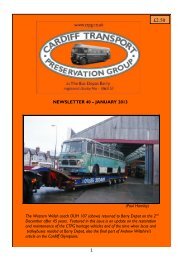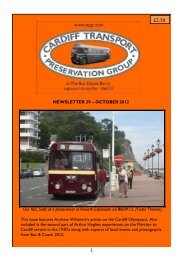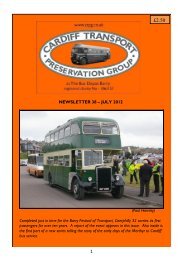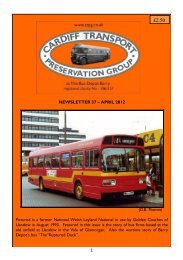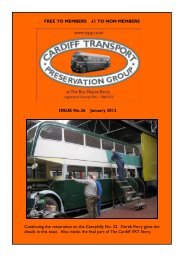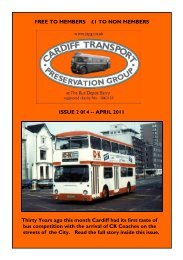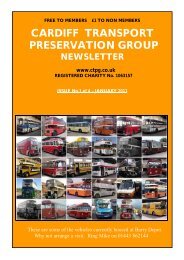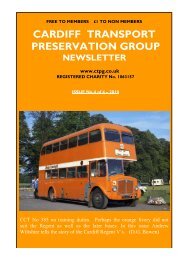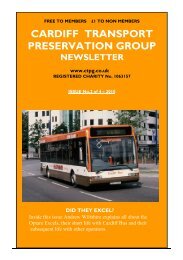2013 – Issue 2 of 4
Create successful ePaper yourself
Turn your PDF publications into a flip-book with our unique Google optimized e-Paper software.
Heritage Buses in South East Wales<br />
Cardiff Transport Preservation Group<br />
Journal 41 April <strong>2013</strong> Price £2.50<br />
BEDWAS & MACHEN 6 RE-LAUNCH<br />
PONTYPRIDD TO CARDIFF IN 1933 by Arthur Hughes<br />
ILLUMINATED BUS ADVERTS SWANSEA EVENT<br />
Leyland Titans back at home in<br />
Caerphilly for the Civic Re-launch <strong>of</strong><br />
Bedwas & Machen 6, here seen<br />
passing Caerphilly 32, on Saturday 2 nd<br />
March <strong>2013</strong>. (Photo: Simon Nicholas)<br />
THE BUS DEPOT, BARRY<br />
Registered Charity No. 1063157<br />
1<br />
www.ctpg.co.uk
At Caerphilly on 2 nd March the newly repainted Leyland PD3 at the civic re-launch.<br />
Below; Civic dignitaries with Wendy Williams <strong>of</strong> the Caerphilly Ladies Choir in her<br />
Welsh National costume.<br />
(Simon Nicholas / Tudor Thomas)<br />
2
CHAIRMAN’S MESSAGE;<br />
Welcome to the Spring edition <strong>of</strong> the Newsletter, now renamed Bustler which we feel<br />
rather suits us since Barry Depot was once branded as “The Home <strong>of</strong> the Bustler”.<br />
Work is progressing towards this year’s events in conjunction with the relevant<br />
councils whose support is obviously much appreciated. Even this early in the year we<br />
have already had plenty <strong>of</strong> publicity, you have probably seen PAX in the Welsh<br />
newspapers or enthusiast press. Early in March we had a civic launch <strong>of</strong> the freshly<br />
repainted Bedwas & Machen bus. The owner <strong>of</strong> this bus, Julian Peddle, attended and<br />
following the event he very kindly donated the bus to the CTPG. During the event we<br />
prepared the groundwork for next year’s proposed 40 th anniversary <strong>of</strong> RVDC<br />
inauguration at which we would like to reunite the three preserved UDC saloons, more<br />
on that in the next few months. The May edition <strong>of</strong> Bus & Coach Preservation also<br />
contains a feature on PAX with several photos taken around the Vale area.<br />
Work on OUH 177G is nearing completion, mainly undertaken by Martyn Evans,<br />
with assistance <strong>of</strong> the mechanical and electrical experts. A successful MOT was obtained<br />
late in March and following lots <strong>of</strong> rubbing down the coach is ready to be taken to TDC<br />
in Lydney for repainting as they did such a good job on PAX. We hope to have it back in<br />
time for the Bristol Habourside rally on 28 th <strong>of</strong> April, please let me know if you would<br />
like to come along we will be taking the stall as normal. At the same event we will be<br />
temporarily handing HWO 323 back to its owner, Martin Bowering, who wishes to use<br />
it during the summer for display at Lydney’s former Red & White bus station. This<br />
popular exhibit will return in the autumn and we hope it will stay at Barry for the long<br />
term.<br />
Other vehicles receiving attention are Caerphilly 3 which continues to be the current<br />
long term restoration. Caerphilly 32 required work on its fuel pump and injectors and<br />
also needs a rear spring change which luckily we have in stock, also Cardiff 434 has had<br />
some panelling repairs and a general tidy up. Work on the Red & White Lodekka has<br />
started initially with a repair to the long term vacuum problem, we hope to replace the<br />
damaged steering box in the next month and follow that with some panelling. We hope<br />
both 32 and 434 will be available to run on our Municipal running day on Sunday May 5 th ,<br />
buses will be running from the Depot to destinations around the Vale and there will be<br />
stalls located inside the Depot.<br />
Finally please come along and help at the events below, as always these events assist<br />
with our funds and keep the Depot running.<br />
Municipal Running Day at the Bus Depot, on Sunday 5 th May<br />
Barry Festival <strong>of</strong> Transport at Barry Island, on Sunday 9th June<br />
Ebbw Vale Classic Bus Day on Saturday 20th July<br />
Bus & Coach Wales at Merthyr Tydfil Leisure Centre on Sunday 8th September<br />
Mike<br />
Tel: 07733 302242<br />
Email : mikeystrad73@btinternet.com<br />
Also keep up to date on our Facebook page<br />
3
BEDWAS & MACHEN SHINES AGAIN IN CAERPHILLY;<br />
By Tudor Thomas<br />
Placing events in history is important when heritage buses reflect different eras in times<br />
past. Bedwas & Machen Urban District Council was created in 1912 and in 1922 ran two<br />
buses but never owned more than nine at any one time, so it was one <strong>of</strong> the UK’s<br />
smallest municipal operators.<br />
In 1974 the council lost control <strong>of</strong> its own buses and became Bedwas, Trethomas &<br />
Machen Community Council within an enlarged Rhymney Valley District Council. Then<br />
in 1996, the community council continued under a further enlarged unitary authority as it<br />
is today, Caerphilly County Borough Council.<br />
On 2 nd March <strong>2013</strong>, on a cold crisp morning a 1979 Leyland Leopard, East Lancs<br />
bodied single decker in Rhymney Valley District Council chocolate, cream and yellow<br />
colours (16, YBO16T) drove into Caerphilly driven by owner Martyn Evans, just as two<br />
Leyland PD3 Massey bodied double deckers ran into the same town. The first, new in<br />
1965, driven by Richard Johnson and the other from 1968 driven by Richard Sanders.<br />
Both <strong>of</strong> these double deckers were in former Urban District Council colours, one in the<br />
mid Brunswick green <strong>of</strong> Caerphilly (32, GNY432C) the other, the star <strong>of</strong> the day, in<br />
Oxford Blue and Royal Ivory colours <strong>of</strong> Bedwas & Machen (6, PAX466F).<br />
The Bedwas & Machen bus was the last UK double decker to carry the sunken<br />
gangway type <strong>of</strong> lowbridge bodywork, with bench seats on the upper deck, and was one<br />
<strong>of</strong> the last Leylands supplied with an exposed radiator when delivered in 1968. In 1974<br />
Bedwas & Machen buses along with Caerphilly and Gelligaer merged into Rhymney Valley<br />
and all those kept were repainted chocolate, cream and yellow. However, number 6 had<br />
a repaint into blue and ivory in 1981 to celebrate 60 years <strong>of</strong> B&M council buses (1922-<br />
1982). Shortly after this Julian Peddle bought the bus for his bus services at Stevensons,<br />
Uttoxeter where it received their mainly yellow livery. It retained this livery when it<br />
passed to MK Metro in Milton Keynes. A couple <strong>of</strong> years ago it arrived at CTPG’s Barry<br />
Depot on long term loan and late in 2012 it was agreed to repaint the bus into its<br />
original Welsh council colours. This was completed in late February <strong>2013</strong> with a week<br />
to spare before its <strong>of</strong>ficial civic re-launch.<br />
The centre <strong>of</strong> any town can be congested but this Saturday morning it was not a<br />
problem, and there were plenty <strong>of</strong> todays’ local Stagecoach buses busy about their<br />
duties. At The Twyn, in the centre <strong>of</strong> the town opposite Caerphilly’s magnificent 11th<br />
century castle, the Bedwas & Machen 1968 Leyland PD3/4 bus pulled up. Nearby was<br />
one <strong>of</strong> Stagecoaches’ brand new Enviro 200’s, specially branded for the newly improved<br />
Caerphilly and The Rhondda services. The presence <strong>of</strong> the blue and ivory bus was seen<br />
by members <strong>of</strong> Caerphilly Ladies Choir and they came out in traditional Welsh costume<br />
adding a splash <strong>of</strong> traditional colour.<br />
CTPG are about restoring touch <strong>of</strong> traditional colour! It was here that a rather<br />
special heritage bus was re-launched in the presence <strong>of</strong> its owner Julian Peddle and<br />
CTPG Chairman, Mike Taylor.<br />
4
Above: The Civic re-launch Left - Mike Taylor, Julian Peddle, The Mayor, Cllr Gaynor<br />
Oliver CCBC , Chairman, Cllr Ray Davies BT&MCC and Vice-Chair, Cllr Liz Aldworth<br />
BT&MCC and below, the heritage buses lined up alongside the Council Offices at<br />
Bedwas.<br />
(Tudor Thomas)<br />
5
The Mayor <strong>of</strong> Caerphilly, Cllr Gaynor Oliver, thanked everyone for coming along and<br />
paid special thanks to Julian Peddle, for allowing the bus to come back to Wales to be<br />
cared for by Cardiff Transport Preservation Group at their restoration centre in Barry.<br />
The 45 year old bus looked resplendent in its newly re-painted Bedwas & Machen<br />
colours, not seen locally for 30 years.<br />
Cllr Ray Davies, Chairman <strong>of</strong> the Bedwas, Trethomas and Machen Community<br />
Council, also spoke on behalf <strong>of</strong> local residents and expressed his pleasure at seeing the<br />
name on the side <strong>of</strong> a bus again. He related some tales <strong>of</strong> his younger days when he was<br />
Chairman <strong>of</strong> the Transport Committee. When they ran their own buses all those years<br />
ago, a report <strong>of</strong> a bus running two minutes late was a taken so seriously that the<br />
Transport Manager was told that heads would roll if it happened again.<br />
The invited guests including councillors, past employees <strong>of</strong> the municipal operators<br />
and The Mayor alighted onto number 6 for a heritage bus ride through the lower part <strong>of</strong><br />
the Rhymney River valley which took in most <strong>of</strong> the former council area. As number 6<br />
left it was joined in convoy by 32 and 16 for a run through Bedwas, Trethomas and<br />
Machen, to come back to Bedwas Council Offices. The three buses lined up outside the<br />
council <strong>of</strong>fices for photographers, whilst those who wanted could see inside a traditional<br />
council chamber completed in 1914. Soon the three buses were back on the road and<br />
dropped guests <strong>of</strong>f at The Twyn. Tea and Welsh Cakes were provided by Caerphilly<br />
County Borough Council Transport Unit and it gave a chance for CTPG members to<br />
relax before retuning homeward.<br />
A guest brought his privately restored 1966 Leyland PD2 with Massey double deck<br />
body in Caerphilly colours (36, LNY536D). While our three buses were away on<br />
convoy duties 36 was able to park at The Twyn, which meant passers-by who missed the<br />
main event, at least saw something was going on.<br />
It was a very successful day for CTPG, the councils and visitors, remaining dry and<br />
the sun shone at the end. Success can be measured in several ways. It was CTPG’s first<br />
civic event for a newly re-livered bus <strong>of</strong> local significance which reflected 100 years <strong>of</strong> a<br />
council that was formed in 1912. It reunited some former staff <strong>of</strong> the municipal bus<br />
undertakings and brought back memories <strong>of</strong> 39 years ago when these councils merged to<br />
form Rhymney Valley. It allowed the buses’ owner Julian, to see at first hand the<br />
reaction from today’s councillors, <strong>of</strong> how civic pride can be rekindled by bringing back a<br />
restored bus in its original livery to its home town. We have had thanks from Caerphilly<br />
Council and Bedwas Trethomas & Machen CC too, so we are winning friends.<br />
We created enough news coverage for our heritage buses for a wider public to know<br />
that we exist and what we are doing. CTPG would especially like to thank Huw Morgan<br />
and Alex Clarke <strong>of</strong> Caerphilly Council and Stephen Wren <strong>of</strong> Stagecoach for their<br />
support and assistance.<br />
Readers may like to checkout “YouTube” as Glyn Bowen has kindly produced a video<br />
<strong>of</strong> the days event. “Bedwas re-launch” is just over 14 minutes and can be seen online by<br />
going to: http://www.youtube.com/watch?v=tH2BSrm0OWY<br />
6
MEMORIES OF BUS COMMUTING IN THE 1930s. PART THREE;<br />
We continue with further extracts from the memories <strong>of</strong> Arthur Hughes who commuted from<br />
Merthyr to Cardiff by bus in the early 1930s. Previous articles were published in issues 38 &<br />
39. (Photos from the Chris Taylor Collection)<br />
Pontypridd to Cardiff.<br />
As we passed Pontypridd on our journey south the road took a sweeping left turn<br />
through a rock cutting, beyond which the town came into view. Below us a jumble <strong>of</strong><br />
factory buildings in the foreground and beyond the ro<strong>of</strong> tops <strong>of</strong> the town a vista<br />
stretching into the distance, up the Rhondda Valley, the hillsides clothed with coal tips<br />
that had replaced the sylvan woods that once flourished there.<br />
At a road junction we made a connection with the up bus on the Cardiff to Ferndale<br />
service, jointly operated by Rhondda Tramways (to become ‘Transport’ in 1934), Thos.<br />
White & Co., and Western Welsh. This connection was much appreciated by anyone<br />
who had to make a journey from the Merthyr direction up into the Rhondda, or vice<br />
versa. To make the same journey by train <strong>of</strong>ten meant a wait <strong>of</strong> up to 45 minutes at the<br />
wild and windy station at Pontypridd while changing trains.<br />
KG 340, White’s Motors first AEC Renown, new in 1931.<br />
At this time the Ferndale service was catered for by Rhondda’s new AEC Regent<br />
double decks with oil engines and metal framed rear entrance Weymann bodies. These<br />
were introduced in early 1934 as replacement vehicle for the company’s tramway<br />
system. Whites Motors usually provided one <strong>of</strong> their two petrol engine AEC Regents<br />
both <strong>of</strong> which had been demonstrators and were later converted to oil. On occasions<br />
these would be replaced by one <strong>of</strong> their six wheel Renowns with Short Bros. or<br />
Weymann bodies. Even today these would be an impressive sight, but way back in 1933,<br />
7
y comparison with the average bus that graced our roads then, they had the appearance<br />
<strong>of</strong> giants among pygmies. For most <strong>of</strong> the time though, these monsters were used on<br />
their Cardiff to Barry service via Wenvoe which was very busy, especially during the<br />
summertime.<br />
Whites livery ironically, contained more blue than white. The blue, not far removed<br />
from royal blue covered the panels up to a white band to include the lower deck<br />
windows, surmounted by two narrow blue bands each side <strong>of</strong> a broad white band<br />
between decks with again white windows for the upper deck. This livery greatly<br />
enhanced the length and general appearance <strong>of</strong> the massive Renowns.<br />
A short distance<br />
further on, at Glyntaff,<br />
we again encountered<br />
the overhead wires <strong>of</strong><br />
the Pontypridd<br />
trolleybuses. This time<br />
however it was on the<br />
connecting line leading<br />
to the depot which we<br />
past, high on the left.<br />
We came alongside<br />
the blackened waters <strong>of</strong><br />
the river Taff which we<br />
followed on its bank for<br />
a few hundred yards<br />
only to lose it again only Pontypridd U.D.C trolleys at their depot<br />
to be glimpsed occasionally<br />
for the rest <strong>of</strong> our journey. Crossing the river at this point were two bridges that led<br />
to the southern suburb <strong>of</strong> Pontypridd, called Treforest. The upper bridge known as the<br />
‘Machine Bridge’ was used by the trolleybuses to link up to the rest <strong>of</strong> the system. It<br />
also fed into the main road other bus routes, namely a local service to Rhydyfelin<br />
worked every 15 minutes by Pontypridd UDC’s Bristol ‘B’ type single deckers, the<br />
Pontypridd to Cardiff service run jointly by Whites, Western Welsh and Rhondda<br />
integrated at this point with the service from Ferndale to provide a 10 minute headway<br />
for most <strong>of</strong> the day,<br />
A service to Caerphilly was worked jointly by Pontypridd and Caerphilly UDC’s. The<br />
latter service was unusual in that it was a new route established, after the 1930 Road<br />
Traffic Act much against the wishes <strong>of</strong> the private bus operators. This proved to be an<br />
unpr<strong>of</strong>itable route and was operated by in the early days with small vehicles. As only<br />
one bus was required to operate this frequency, a solution had to be found for a joint<br />
service, thus it came about that each operator provided a bus for half <strong>of</strong> the day,<br />
alternating mornings and evenings every other week. This solution was not without its<br />
problems as when it was Caerphilly’s morning turn they ran light to Pontypridd to start<br />
the service, but when on evenings rather than repeat this procedure a timetabled<br />
8
journey was ran. This journey was omitted when it was Ponty’s turn, which must have<br />
posed a puzzler to some sozzled soul striving to remember what week it was and<br />
whether there would or not be a last bus home for him. Caerphilly livery was originally<br />
red and cream but by 1933 had become a somewhat dull, almost olive, green with little<br />
to relieve its monotony, on these older vehicles anyway.<br />
At this time Western Welsh was not well endowed with double deck buses so the<br />
Pontypridd to Cardiff was <strong>of</strong>ten operated by a single deck, <strong>of</strong>ten drawn from their<br />
collection <strong>of</strong> ‘hand me downs’ acquired from SWCM or GWR. Western Welsh livery<br />
was a pleasing bright red beneath white which extended over the ro<strong>of</strong> the windows<br />
however were picked out in matching red. They carried a distinctive illuminated sign<br />
having the letters W and W in white against a black background, integrated with each<br />
other and located just above the destination box. The words ‘Western Welsh’ were<br />
picked out in gold paint on the side panels, though in varying styles.<br />
Just below the Machine Bridge another similar bridge carried a road over to<br />
Treforest and here a connection could be made with The Pontypridd to Porthcawl<br />
service jointly run by Western Welsh and Rhondda. The word ‘connection’ is used<br />
loosely, as to get to the Porthcawl route meant having to cross the bridge and proceed a<br />
further 200 yards up hill where it was impossible to see the bus coming until it was upon<br />
you.<br />
ABS Thornycr<strong>of</strong>t A1 <strong>of</strong> Mr. Gray, Tonteg.<br />
9<br />
The Porthcawl road also<br />
carried a frequent service<br />
<strong>of</strong> buses operated by the<br />
Amalgamated Bus Services<br />
organisation. This was an<br />
association formed by<br />
several independent<br />
operators in a fight against<br />
the big companies who<br />
were trying to run them<br />
<strong>of</strong>f the road. For the most<br />
part Thornycr<strong>of</strong>t A1’s and<br />
A2’s predominated in the<br />
ABS fleet, painted a dull<br />
red with white windows<br />
and ro<strong>of</strong>, though there<br />
were many variations to this. At this time there were five members and remarkably<br />
some stayed together well into the post-war years. They were finally reduced in number<br />
by consolidations <strong>of</strong> one sort or another rather than any takeover by one <strong>of</strong> the big<br />
companies. The most well<strong>–</strong>known, longest lasting name in the ABS was S.A. Bebb <strong>of</strong><br />
Llantwit Fardre who absorbed the last <strong>of</strong> the ABS members in 1974.<br />
After Rhydyfelin and Upper Boat the scenery changed to a more rural setting with<br />
the winding road passing green fields on either side in the much widened valley. This<br />
tranquil scene was shattered in the mid-1930s and thereafter by the construction <strong>of</strong> the
Treforest Trading Estate. Why it was named Treforest I don’t know as we had past that<br />
village some two miles back.<br />
The village <strong>of</strong> Nantgarw, which was once famous for its porcelain, saw us exchange<br />
the Pontypridd to Caerphilly service that branched <strong>of</strong>f left up a steep hill. The Markham<br />
to Cardiff service also descended the same hill. This latter route was another joint<br />
operation provided by Cardiff Corporation, Caerphilly UDC and West Monmouthshire<br />
Omnibus Board and operated hourly on Mondays, Tuesdays and Wednesdays. The<br />
frequency was boosted up the rest <strong>of</strong> the week to half hour headway. Cardiff turned out<br />
their Leyland Tigers for this service, with Caerphilly using TSM B10A’s or Thornycr<strong>of</strong>t<br />
Cygnets. West Mon used their Leyland Lions which were painted in maroon, slightly<br />
darker than Rhondda’s fleet, with a light cream band beneath the windows. The fleetname<br />
was picked out in gold with an elaborate crest between West and Mon.<br />
A further mile brought us to the straggling village <strong>of</strong> Taffs Well at whose southern<br />
end the valley again narrowed to become a wooded gorge dominated on the left by<br />
Castle Goch perched high amongst the trees. The valley floor squeezed in two railway<br />
lines, two roads, a canal and <strong>of</strong> course the river Taff, while overhead, over 100 feet up in<br />
the air, soared the massive Walnut Tree Viaduct. This structure <strong>of</strong> lattice steel girders<br />
carried a freight line <strong>of</strong> the former Barry Railway which tapped the rich coalfields <strong>of</strong> the<br />
West Monmouthshire valleys. (This edifice was demolished in the 1970s though one<br />
masonry pier still remains. Ed.) Here we were also joined by another bus service which<br />
operated on a two hourly headway. This was the Western Welsh service from Church<br />
Village to Cardiff which usually saw one <strong>of</strong> their more ancient buses in operation.<br />
After Tongwynlais we reached the northern outskirts <strong>of</strong> Cardiff in the form <strong>of</strong> a<br />
collection <strong>of</strong> houses known as Hollybush. Here we performed the morning ritual <strong>of</strong><br />
picking up the tea can, as just <strong>of</strong>f the main road lived a lady who earned a little pin money<br />
by providing billycans <strong>of</strong> steaming tea to the inward bound bus crews. This was used to<br />
wash down their sandwiches which they gobbled down during their layover at Cardiff.<br />
Once aboard it was the conductor’s duty to see that the precious liquid did not spill<br />
over during the rest <strong>of</strong> the journey.<br />
A little under a mile further on we reached Whitchurch and the terminus <strong>of</strong> Cardiff’s<br />
23 service that served this place. Incidentally, although joined up to the city by a built up<br />
area, Whitchurch lay outside the city boundary. The 23 route was integrated with the<br />
Pontypridd-Cardiff service providing a 5 minute frequency for most <strong>of</strong> the day however<br />
after the city boundary at Riches Road was reached the Pontypridd buses were only<br />
allowed to set down passengers.<br />
Outstanding in my memory were two Dennis 4 tonners from about 1925/6 with<br />
covered tops but open staircases that crept along at a sedate pace between Whitchurch<br />
and the city centre on their solid tyres. Even the most modern buses that put in an<br />
appearance on this route, namely some <strong>of</strong> the four Thornycr<strong>of</strong>t LC double decks bought<br />
in 1930, had the look and style <strong>of</strong> an earlier period.<br />
10
(These Thornycr<strong>of</strong>ts LC’s were fitted with 4 cylinder engines as the new manager at Cardiff,<br />
Wm. Forbes, had a liking for this type <strong>of</strong> engine. They were obtained with a huge discount at<br />
£765 for the chassis and £500 for the body by Hall Lewis, who were then in liquidation. In<br />
1934 the batch received Gardner oil engines. Ed.)<br />
On we travelled along what had now became North Road to Gabalfa where to our<br />
left, in what was perhaps the inappropriately named Whitchurch Road, as it never went<br />
near the place, was the terminus <strong>of</strong> the No. I tram route. Colum Road ushered us into<br />
Cardiff’s magnificent civic centre and on to our terminus at the Gorsedd Gardens<br />
directly opposite the city hall clock which usually hovered between 9.00 and 9.05am<br />
when we arrived. Gorsedd Gardens was also the terminal point for the services from<br />
Pontypridd, Ferndale, Aberdare/Swansea, Church Village and Markham all <strong>of</strong> which took<br />
a different approach to the place than we did, coming down North Road instead <strong>of</strong><br />
Colum Road.<br />
As we reached our destination, a quick wave to the driver as we passed his cab and<br />
we raced <strong>of</strong>f to our respective places <strong>of</strong> work, leaving the bus empty for the crew to<br />
partake <strong>of</strong> their sandwiches plus <strong>of</strong> course, the contents <strong>of</strong> the billycan so carefully<br />
guarded by the conductor.<br />
(In a future edition we will dip into Mr Hughes’ experiences <strong>of</strong> buses in Cardiff City. Ed.)<br />
11
12
13
SEEING THE LIGHT; by Paul Burgess<br />
As the swinging sixties dawned, the boom years for Britain’s bus industry were beginning<br />
to slip away. With passenger numbers and ticket revenues falling, economies were<br />
sought, and secondary sources <strong>of</strong> revenue keenly examined. Mobile advertising may not<br />
have been new, but many fleets increased the number carried, and others introduced<br />
them for the first time. Some fleets saw long established liveries altered to<br />
accommodate adverts, much to the dismay <strong>of</strong> many observers. Cheaper ways <strong>of</strong><br />
applying adverts also followed, using printed paper rolls, though the growing trend<br />
toward all-over adverts would keep sign writers busy for several more years. The next<br />
development came about for two somewhat different reasons, both the result <strong>of</strong><br />
advancements in technology.<br />
Those <strong>of</strong> you with classic cars (or a long memory) will be familiar with the dynamo,<br />
an electrical generator which can trace its roots back to Michael Faraday. The humble<br />
dynamo produced a meagre output for its size, and nothing when the engine was at idle.<br />
Regular renewal <strong>of</strong> carbon brushes and adjustment <strong>of</strong> mechanical control boxes gave<br />
fleet electricians plenty to do. The alternator changed all this at a stroke. It effectively<br />
squeezed three dynamos into the space <strong>of</strong> one, did away with high-current brushes and<br />
even produced useful power at idle speed. All <strong>of</strong> a sudden buses had far more electrical<br />
power available, and the fleet electricians could relax a little. Buses stranded with flat<br />
batteries became a rarity, and it was soon realised that there was power to spare.<br />
Around 1958 Phillips announced the transistorised lighting inverter which turned flat<br />
electricity (dc) into the wavy electricity (ac) needed by fluorescent tube lighting. This<br />
major advance gave the double benefit <strong>of</strong> increased lighting levels yet using less power<br />
than traditional filament lamps. Looking at it another way, there was power to spare!<br />
Advertising agencies like Griffiths & Millington immediately realised that this new<br />
technology was well suited for illuminated exterior adverts, <strong>of</strong>fering advertisers the<br />
chance to brightly display their messages along every route. Many larger fleets took<br />
delivery <strong>of</strong> buses equipped with large illuminated panels, most being double deckers.<br />
Locally, Western Welsh and Red & White both signed up, but Cardiff Corporation<br />
perhaps wisely declined. After a few short years, the novelty had worn <strong>of</strong>f, and<br />
advertisers baulked at the extra cost. Most were abandoned and covered by<br />
conventional paper or vinyl adverts. Many operators removed all trace <strong>of</strong> them at<br />
overhaul, with the result that very few survive into preservation.<br />
Cardiff did however acquire some Tyne & Wear Atlanteans following extensive<br />
hiring in 1977. Perhaps reflecting the shortage <strong>of</strong> vehicles, 24 JVK was hurriedly outshopped<br />
in CCT orange with its previous owners illuminated advert untouched. After<br />
the missing fuse was reinstated, (no idea by whom) the full effect <strong>of</strong> its vibrant blue and<br />
yellow message- “It’s more than a good job with the PTE”, blazed ironically out over the<br />
streets <strong>of</strong> Cardiff.<br />
14
Red & White took several Lodekkas and<br />
Western Welsh had some Atlanteans with<br />
<strong>of</strong>fside adverts, but these seem to be all.<br />
Notable rarities were a batch <strong>of</strong> South<br />
Wales Transport AEC Reliances with<br />
illuminated ro<strong>of</strong> cove adverts.<br />
Very few nocturnal images <strong>of</strong> working<br />
advert panels are known, but happily<br />
Aldershot & District Dennis Loline 462<br />
EOT has recently been restored with a<br />
working illuminated period advert for a<br />
motor dealer.<br />
The advent <strong>of</strong> LED arrays has seen a revival <strong>of</strong> the illuminated advert now capable <strong>of</strong><br />
animated images. One wonders if it will find greater success this time!<br />
As used on some Western Welsh Atlanteans.<br />
15
16
17
Vale & Valley Link December 1976<br />
18
SWANSEA BUS MUSEUM RUNNING DAY;<br />
On the 24 th February CTPG members took their two Massey bodied Leyland PD’s, the<br />
former Bedwas & Machen U.D.C. No. 6 and Caerphilly’s No.32 to the Swansea event on<br />
a bitterly sub-zero day.<br />
Both vehicles behaved impeccably a tribute to those who have worked on them. It<br />
was the first event that No.6 had undertaken in its original livery and it looked superb.<br />
The only down side to the day was the attendance probably due to the low temperature<br />
and the Capital Cup Final involving Swansea City and Bradford.<br />
19<br />
At the museum it was very<br />
interesting to see their<br />
restoration <strong>of</strong> the 1959 AEC<br />
Bridgemaster UCY 837 was well<br />
advanced, a mammoth task if<br />
there ever was one. This vehicle<br />
was formerly 1203 in the fleet <strong>of</strong><br />
South Wales Transport Co. Ltd.<br />
The road runs followed the<br />
usual routes to Oystermouth,<br />
Mumbles, Caswell Bay, Pennard<br />
and Swansea town centre using<br />
former S.W.T. AEC Regents and<br />
Bristol VRT’s, a AEC Reliance <strong>of</strong><br />
Neath & Cardiff Coaches as well as our own Leyland PD’s.<br />
On display for the first time was the AEC 403 type, CY 5981 which had been<br />
acquired during 2012 still<br />
bearing South Wales<br />
Transport signage. This was<br />
from the second batch <strong>of</strong> this<br />
type <strong>of</strong> AEC bus purchased<br />
by SWT and is now 90 years<br />
old. Unfortunately this<br />
acquisition lacks an engine<br />
and gear box and is viewed as<br />
a long term project.<br />
This museum is well worth<br />
another visit. Let’s hope the<br />
weather is warmer next time.<br />
Paul Gilbertson
FEBRUARY MEETING -- LIVING WITH THE PAST;<br />
This was a slide show entitled, “Living in the Past” with commentary, presented by Mac<br />
Winfield. The start <strong>of</strong> our show was delayed slightly by our discussion <strong>of</strong> the new<br />
Barry Rally Site for the <strong>2013</strong> Barry Festival <strong>of</strong> Transport, but eventually got underway<br />
at 20:00.<br />
As the date <strong>of</strong> the evening meeting (20 th February <strong>2013</strong>), was the 63 rd anniversary <strong>of</strong><br />
the closure <strong>of</strong> the Cardiff Corporation Tramway system, appropriately, a series <strong>of</strong><br />
Cardiff tramway photos were presented. These showed double and single deck cars<br />
during the hey-day <strong>of</strong> Cardiff tram operation in the mid-1930s until closure <strong>of</strong> the<br />
system in 1950. Cars were seen in Cardiff’s main thoroughfare Queen Street in 1938,<br />
Newport Road during war time, Clare Road, Clarence Road, City Road and<br />
Adamsdown including the last tram journey from Whitchurch Road to St. Mary Street<br />
on the final day.<br />
Cardiff Trams No’s 1 and 70 in Castle Street in 1939.<br />
The next section dealt with London’s Trolleybuses, starting from 1931 with the<br />
introduction <strong>of</strong> the famous London United Traction “Diddlers” the 60 vehicles built by<br />
U.C.C. at Feltham were <strong>of</strong>ficially classified A1 and A2 in 1933 by the then newly formed<br />
London Passenger Transport Board who took over all <strong>of</strong> London’s major road passenger<br />
and railway operating companies in that year.<br />
20
A brief history <strong>of</strong> the vehicle identification codes, applied by the L.P.T.B. was given<br />
along with a list <strong>of</strong> the 21 garages, (depots) from which the Trolleybuses operated<br />
between 1931 and the end <strong>of</strong> Trolleybus operation on the 8 th May 1962. Colour and<br />
black and white images were displayed <strong>of</strong> the many common types along with a few <strong>of</strong><br />
the experimental types taken into stock between 1935 and 1940, one <strong>of</strong> the most<br />
interesting <strong>of</strong> these was the Leyland built 4 wheel turning vehicle number 1671, this bus<br />
remained the solitary vehicle <strong>of</strong> this type along with the only 2 axle Trolleybus. At one<br />
point the London Trolleybus system was the largest in the world with over 1.600<br />
vehicles in use, though all told there were 1891 vehicles owned and it remained the<br />
largest system in the UK.<br />
The next item dealt with was the privatised liveries <strong>of</strong> the British railway system.<br />
These slides were restricted to Locomotive operating companies, covering EWS,<br />
Railfreight, Load Haul, Advenza Rail, Colas Rail and a few others. Locos seen were <strong>of</strong><br />
classes 08, 20, 31,37,56, 57, 60, 66, and 67<br />
A break <strong>of</strong> about 15 minutes was then taken as is usual before the second part <strong>of</strong> the<br />
programme which commenced with Northern Municipal Buses <strong>of</strong> the 1950s and 60s, a<br />
chance to see vehicles <strong>of</strong> body types rarely seen in South Wales. Photographs <strong>of</strong><br />
vehicles were shown from the fleets <strong>of</strong> Northampton, Burton, Aston-under-Lyne, Derby,<br />
Leeds and Middlesborough, to name but a few.<br />
Eddie Stobart came up next with 24 views showing, 23 vehicles including their<br />
coach. As would be expected this is quite a modern fleet <strong>of</strong> trucks <strong>of</strong> various types and<br />
chassis makes with trailers to suit every type <strong>of</strong> transport operation, which include<br />
curtain siders, biomass trailers, refrigeration, containers, tankers and timber trailers to<br />
name a few. Vehicles <strong>of</strong> Volvo, Scania, M.A.N, Mercedes and DAF manufacture were<br />
seen at Carlisle and Crick depots as well as in action on Britain’s miles <strong>of</strong> motorway.<br />
Our last few slides were <strong>of</strong> the two preserved AEC Regal IIIs one former Gelligaer U.<br />
D. C. Longwell Green bodied bus <strong>of</strong> 1954 vintage now a resident <strong>of</strong> the Welsh Museum<br />
Collection and the other former Bedwas & Machen U.D.C. number 7, JWO355 the only<br />
Bruce bodied saloon in captivity, seen in service in the 1950s and 60s and also seen in its<br />
more recent surroundings in Durban, South Africa…….can it be repatriated ?<br />
I think all present enjoyed the evening and hope we can do it again.<br />
--------------------------------------------------------------------<br />
Mac Winfield.<br />
21
MARCH MEETING --BERWYN'S FILM NIGHT<br />
The film show started with footage <strong>of</strong> the launch <strong>of</strong> ex-Bedwas & Machen PD3 PAX466F<br />
by the Mayor <strong>of</strong> Caerphilly on the very cold morning <strong>of</strong> 2 March <strong>2013</strong>.<br />
Most <strong>of</strong> the rest <strong>of</strong> the programme showed scenes from the rallies our member<br />
Berwyn Pryce Jones had been to during 2012, all <strong>of</strong> which had, somewhat remarkably<br />
considering the poor weather <strong>of</strong> 2012, been held in dry conditions even if not particularly<br />
warm and sunny.<br />
Our first visit on screen was to the Wythall Bus Museum where the crowds were so<br />
large that a car park on a nearly business estate had to be utilised for parking with two<br />
buses <strong>–</strong> one an ex-WMPTE single-deck Fleetline <strong>–</strong> used to ferry visitors to the museum<br />
site. An added attraction for this visit was the inclusion <strong>of</strong> vehicles from the Aston Manor<br />
collection as both static and running exhibits.<br />
Just to add some variety to the proceedings and on a strictly non-bus theme, there<br />
followed a short interlude along the lines <strong>of</strong> ‘Who Do You Think You Are?’ television<br />
programme when the presenter described how he’'d traced his aunt’s youngest sister and<br />
arranged for them both to meet for the very first time, one aged 84 and the other 88.<br />
Back to the buses and visits were paid to both the Group’s rallies at Barry and<br />
Merthyr, to the Beachley, Brislington, Swansea and Warminster Running Days, and to two<br />
new events, the Newbury Bus Rally and the (new-style) Crosville running day at Weston-<br />
Super-Mare. To add a little more variety, a holiday in Scotland produced footage <strong>of</strong> two<br />
preserved MacBraynes coaches on their way to a rally in the Highlands and <strong>of</strong> a visit to<br />
the new Waterside Museum in Glasgow where all the transport exhibits (four steam<br />
engines, two trams and a single bus) are laid out in such a way as to make it almost<br />
impossible to film or photograph them satisfactorily.<br />
Two short sequences with birds <strong>of</strong> the feathered variety were also included: one <strong>of</strong> a<br />
ringed plover almost totally camouflaged by pebbles on a remote beach on Skye and the<br />
other <strong>of</strong> a seagull happily bringing up her two chicks on spare track at Mallaig station<br />
despite the daily visits <strong>of</strong> ‘The Jacobite’ steam train from Fort William!<br />
--------------------------------------------------<br />
Berwyn Prys Jones<br />
22
1954 Advert featuring KDW 259 <strong>of</strong> Newport Corporation<br />
23
DATES FOR YOUR DIARY;<br />
Meetings will be held at Penarth Conservative Club at 19.30 on the third Wednesday <strong>of</strong><br />
the month. Summer Road Runs from Barry Depot will leave at 19.00.<br />
Sun. 28 th Apl.<br />
Sun. 5 th May<br />
Wed. 15 th May<br />
Sun. 18 th May<br />
Sun. 9 th June<br />
Sun. 16 th June<br />
Wed 19 th June<br />
Sat. 22 nd June<br />
Sun. 14 th July<br />
Wed. 17 th July<br />
Sat. 20 th July<br />
Sun. 11 th Aug.<br />
Wed. 21 st Aug.<br />
Sun. 8 th Sept.<br />
Wed. 18 th Sept.<br />
Sat. 28 th Sept.<br />
Wed. 16 th Oct.<br />
Sun. 27 th Oct.<br />
Wed. 20 th Nov.<br />
Wed. 18 th Dec.<br />
Bristol Harbourside Rally and Running Day.<br />
CTPG Municipal Running Event and Depot Open Day.<br />
Road Run T.B.A.<br />
Wales on Wheels event at Swansea Waterfront Museum.<br />
<strong>2013</strong> Barry Festival <strong>of</strong> Transport to be held at Barry Island.<br />
Swansea Bus Museum Open Day and Festival <strong>of</strong> Transport.<br />
Road Run T.B.A.<br />
Abertillery Classic Vehicle Show<br />
Glos & Warks Railway Bus Rally at Toddington Station.<br />
Road Run T.B.A.<br />
Ebbw Vale Classic Bus Day.<br />
Brislington Rally & Running Day , Bristol.<br />
Road Run T.B.A.<br />
Bus & Coach Wales <strong>2013</strong> at Merthyr Tydfil Leisure Centre.<br />
Joint Meeting with Omnibus Society.<br />
Red & White Reunion Rally at Beachley.<br />
Meeting T.B.A.<br />
Swansea Bus Museum Open Day.<br />
Meeting T.B.A.<br />
Annual Quiz Night with Chris Taylor.<br />
Details <strong>of</strong> all events will be updated regularly on our website. www.ctpg.co.uk<br />
We hope you have enjoyed the first issue <strong>of</strong> “Bustler.” We have thought for some time<br />
that our quarterly was a bit more than just a newsletter. The chosen name is also<br />
appropriate as our home at Barry was also the first home to the “Bustler” back in 1986.<br />
REMINDER! We can now send members our newsletter in PDF format straight to your<br />
computer. This will save the group printing and postage costs. If you would like this<br />
facility, please inform the editor at viv.corbin@ntlworld.com<br />
No one has resolved the mystery bus<br />
featured in the last issue. GTX 484 was a<br />
Gilford Hera with Alexander C32F body<br />
used by E C Morgan <strong>of</strong> Tonypandy. It had<br />
been new to WSMT in 5/34 as CS 119.<br />
After war service with the Royal Navy as<br />
RN 7352 it was re-registered by Sidney<br />
Davies (dlr) <strong>of</strong> Penygraig in 1948.<br />
24
25
About the CTPG<br />
The CTPG lease the former Western Welsh Depot on Broad Street, Barry from the Vale <strong>of</strong><br />
Glamorgan Council. The CTPG organises two vehicle rallies each year and holds a monthly<br />
meeting on the third Wednesday <strong>of</strong> each month at the Penarth Conservative Club. Members<br />
receive a quarterly journal recently renamed BUSTLER and if they wish they can help to restore<br />
the Group’s buses, ride on them and travel to rallies.<br />
The Group aims to preserve representative samples <strong>of</strong> the buses that ran in South East Wales and<br />
the Valleys, as well as memorabilia and records <strong>of</strong> the operating companies.<br />
Annual membership <strong>of</strong> the Group is £20, which runs from the date <strong>of</strong> joining. Joint membership is<br />
also available for £25.<br />
CTPG Committee<br />
Chairman<br />
Deputy Chairman<br />
Secretary<br />
Mike Taylor, 10 Ger Nant Ystrad Mynach, Hengoed CF82 7FE<br />
Phone: 07733 302242<br />
email: mikeystrad73@btinternet.com<br />
Chris Taylor, 31 Heol Wen, Rhiwbina Cardiff CF14 6EG<br />
Phone: 02920 693734<br />
Gayle Alder, 16 Carter Place, Fairwater, Cardiff CF5 3NP<br />
Treasurer Paul Hamley email: squash33@btinternet.com<br />
Membership Secretary<br />
Derek Perry, 11 Countess Place, Penarth CF64 3UJ<br />
Other Non Committee Post Holders<br />
Bustler Editor Viv Corbin email: viv.corbin@ntlworld.com<br />
Webmaster CTPG Mac Winfield email: info@ctpg.co.uk<br />
Publicity Officer Tudor Thomas email: tudoralt@cf14.freeserve.co.uk<br />
www.ctpg.co.uk<br />
Published by the Cardiff Transport Preservation Group<br />
(Registered as a Charity No. 1063157)<br />
The opinions and views expressed in this publication are not necessarily those <strong>of</strong> the Group, its<br />
Committee or the Editor. Every effort is made to give due credit for all photographs and material<br />
used in this newsletter. Should there be any unintended breach <strong>of</strong> copy right; the Editor must be<br />
informed to enable a correcting acknowledgement to be made.<br />
26
Former Western Welsh 675 was sought out by Paul Gilbertson on 15 th February resting in the<br />
East Midlands. Below; Paul Hamley says he lined up his camera at the Caerphilly re-launch<br />
and the statue <strong>of</strong> Tommy Cooper appeared <strong>–</strong> “Just Like That!” Ding Ding - Fez Please!<br />
27
28




